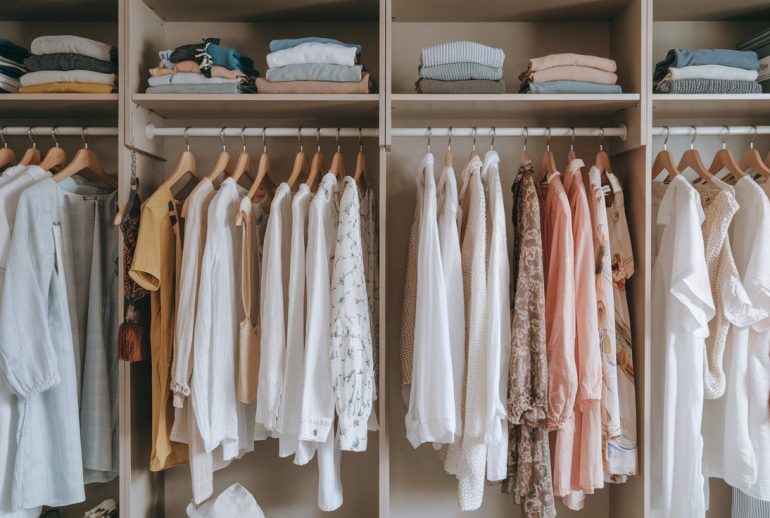When it comes to fashion, there’s a growing conversation about the impact our clothes have on the planet. Eco-friendly fashion is all about minimizing harm, using sustainable materials, and fair labor practices. On the other hand, conventional fashion often prioritizes fast production and lower costs, sometimes at the expense of the environment and workers. In this article, we’ll explore how these two approaches stack up against each other.
Key Takeaways
- Eco-friendly fashion focuses on sustainable materials and ethical production, aiming to reduce environmental impact.
- Conventional fashion often prioritizes speed and cost, which can lead to environmental and ethical concerns.
- Sustainable fashion uses materials like organic cotton and recycled fibers, while conventional fashion may rely on synthetic materials.
- Consumers can make informed choices by looking for certifications and researching brand practices.
- Both eco-friendly and conventional fashion have their pros and cons, influencing cost, accessibility, and impact.
Understanding the Basics of Eco-Friendly and Conventional Fashion
Defining Eco-Friendly Fashion
Eco-friendly fashion, often known as sustainable fashion, focuses on creating clothes in a way that is mindful of the environment and the people involved in the production process. This means using materials that are less harmful to the environment, like organic cotton or recycled fibers, and ensuring fair labor practices. Sustainable fashion aims to minimize the carbon footprint and reduce waste, making it a more responsible choice for consumers. It’s not just about the materials, but also about the lifecycle of the products—from production to disposal.
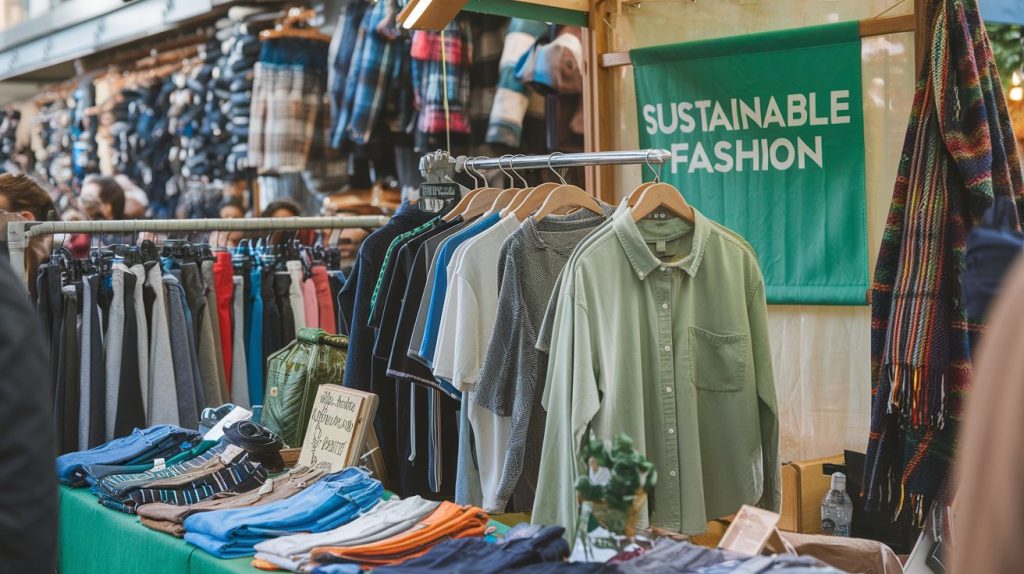
Characteristics of Conventional Fashion
Conventional fashion, on the other hand, is what you typically find in fast fashion outlets. This type of fashion is all about speed and low cost, often at the expense of the environment and workers’ rights. It involves mass production of clothing, which leads to high levels of waste and pollution. The use of synthetic materials, which are cheaper and quicker to produce, often results in garments that don’t last long and contribute to landfill waste.
Key Differences Between the Two
- Material Usage: Eco-friendly fashion uses sustainable materials like organic cotton and recycled fibers, whereas conventional fashion relies heavily on synthetic materials.
- Production Practices: Sustainable brands focus on ethical production, ensuring fair wages and safe working conditions, while conventional fashion often cuts corners to save costs.
- Environmental Impact: The eco-friendly approach aims to reduce water usage, pollution, and carbon emissions, unlike conventional methods that significantly contribute to these issues.
The shift towards sustainable fashion is not just a trend but a necessary transition for a healthier planet and society. It encourages consumers to think about the impact of their purchases and opt for quality over quantity.
By understanding these differences, consumers can make more informed choices, supporting brands that align with their values and contribute to a more sustainable future. Slow fashion emphasizes eco-friendly materials, utilizing sustainable fabrics such as organic cotton, Tencel, and recycled fibers that consume less water and energy.
Environmental Impact: Sustainable vs. Traditional Fashion
Water Usage in Fashion
Water is a big deal in fashion, especially when it comes to traditional methods. Making just one cotton t-shirt can use up to 2,700 liters of water. That’s like running your shower non-stop for three days. This consumption doesn’t just drain water supplies; it also impacts communities relying on these resources. On the flip side, sustainable fashion is all about cutting down on water use. Brands in this space often go for materials like organic cotton, which uses way less water.
Chemical Pollution Concerns
Traditional fashion is notorious for its heavy use of chemicals. Dyes and treatments often end up in rivers and oceans, messing with aquatic life and even contaminating local water sources. Sustainable fashion, however, tries to avoid this mess. It leans towards natural dyes and eco-friendly treatments, helping to keep our water cleaner.
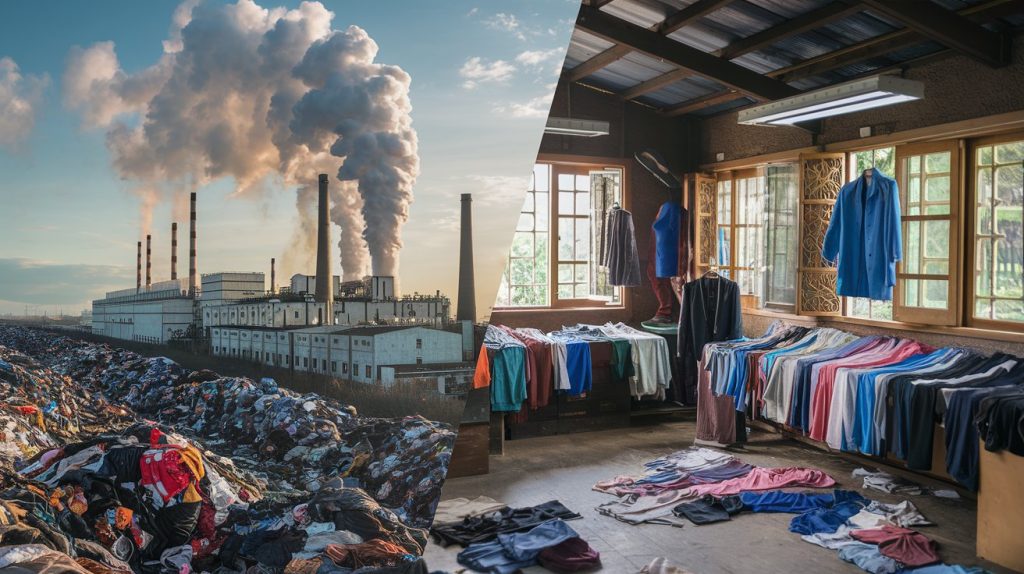
Carbon Footprint of Fashion
The fashion industry is a huge contributor to global carbon emissions, accounting for about 10%—more than international flights and shipping combined. Traditional fashion’s production processes and global transportation are major culprits. But sustainable fashion is stepping up. By using renewable energy and optimizing supply chains, these brands are working hard to shrink their carbon footprint.
Choosing sustainable fashion isn’t just about looking good; it’s about feeling good knowing you’re making a positive impact on the planet. By opting for eco-friendly brands, you’re supporting a movement that values the environment and ethical practices over quick trends.
- Traditional Fashion:
- Sustainable Fashion:
For more on how fashion impacts our world, check out this article that dives into the challenges and changes within the industry.
Materials and Production: A Closer Look
Eco-Friendly Materials in Fashion
Eco-friendly clothing brands often use materials that are both sustainable and durable. Eco-friendly clothing brands prioritize sustainability by utilizing low-impact dyes, upcycled natural materials, and organic cotton to produce high-quality apparel. These materials are designed to minimize environmental impact and promote a healthier planet. However, the cost of these materials can be higher due to the rigorous processes involved in their production. For instance, organic cotton requires soil that has been free from chemicals for several years, ensuring that the crop grows naturally without harmful fertilizers.
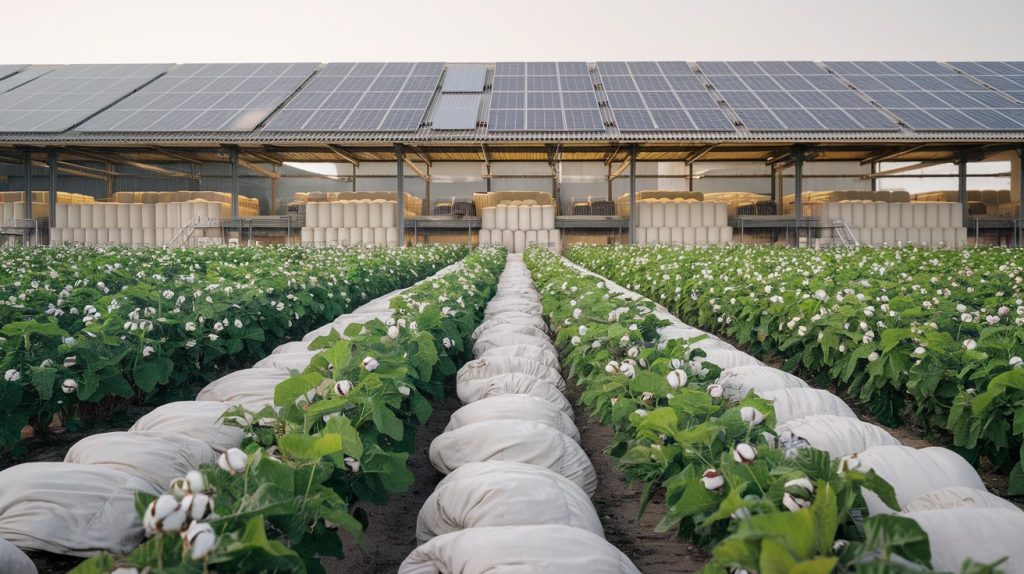
Ethical Production Practices
Ethical production is a cornerstone of sustainable fashion. This involves fair labor practices, safe working conditions, and environmentally friendly manufacturing processes. Unlike fast fashion, which often cuts corners to reduce costs, sustainable brands invest in ethical practices that prioritize the well-being of workers and the environment. This might mean slower production times and higher costs, but the result is a more sustainable and ethical product.
Challenges in Sustainable Production
Producing sustainable fashion isn’t without its challenges. The demand for eco-friendly textiles is still relatively low compared to conventional materials like polyester and non-organic cotton. This lower demand can make sustainable materials more expensive. Additionally, sustainable production often requires more time and resources, from sourcing natural dyes to ensuring fair labor practices. Despite these challenges, the push for sustainable fashion is gaining momentum, with new technologies and techniques helping to reduce costs and improve efficiency.
The journey to sustainable fashion is not just about changing materials, but also about transforming the entire production process to be more ethical and environmentally conscious.
Consumer Choices: Making Informed Decisions
Spotting Sustainable Brands
Finding a sustainable brand isn’t just about looking for a green label or an eco-friendly tag. It’s about understanding the brand’s core values and practices. Look for brands that emphasize transparency in their supply chain and those that actively reduce their carbon footprint. These brands typically provide detailed information on their manufacturing processes and materials used.

- Transparency: Brands should openly share their production processes.
- Materials: Use of organic or recycled materials is a good indicator.
- Certifications: Look for recognized eco-labels.
The Role of Certifications
Certifications can act as a reliable guide in identifying genuinely sustainable brands. Various organizations provide certifications that verify a brand’s commitment to environmental and ethical standards. Some key certifications to look out for include:
- Global Organic Textile Standard (GOTS) – Ensures organic status of textiles, from harvesting to labeling.
- Fair Trade Certified – Focuses on fair wages and working conditions.
- OEKO-TEX® – Certifies textiles free from harmful substances.
These certifications help consumers make informed choices by providing assurance that the products meet high environmental and ethical standards.
Impact of Consumer Behavior
The choices we make as consumers have a significant impact on the fashion industry. By prioritizing sustainable options, we can influence brands to adopt more eco-friendly practices. It’s not just about buying less, but buying better. Consider these points:
- Demand Change: When consumers demand sustainable products, brands are more likely to supply them.
- Support Ethical Practices: Purchasing from brands with ethical labor practices encourages fair treatment of workers.
- Long-Term Investment: Sustainable fashion often means higher initial costs, but it proves to be a long-term investment in quality and durability.
Making the shift towards sustainable fashion is not just a trend; it’s a necessary change for the future of our planet. By aligning sustainability with consumer desires, we can transform the narrative around brand affinity and promote more responsible fashion choices.
Economic Considerations in Fashion Choices

Cost of Sustainable Fashion
Sustainable fashion often comes with a higher price tag. Why? It’s about the upfront investment in eco-friendly materials and ethical labor standards. These clothes are made to last, with quality materials that don’t harm the planet. Higher initial costs can deter some buyers, but they reflect fair wages and safe working conditions for those who make them.
Investing in sustainable fashion is about more than just clothes; it’s about supporting a system that values people and the planet.
Affordability of Fast Fashion
Fast fashion is cheap and everywhere. It’s tempting to grab a trendy piece for a few bucks. But this affordability comes at a cost. Fast fashion is often linked to poor labor conditions and environmental harm. It’s a cycle of buying more and wasting more. Here’s why it’s so cheap:

- Mass production with low-quality materials
- Cutting corners on labor costs
- Ignoring environmental impacts
Long-Term Value of Eco-Friendly Clothing
Eco-friendly clothing may cost more upfront, but it pays off in the long run. These pieces are durable, reducing the need to buy new clothes frequently. Plus, they often come with benefits like recycling programs or repair services. Consider these long-term perks:
- Longer-lasting materials mean fewer replacements
- Supports ethical practices and fair wages
- Reduces your environmental footprint
Choosing sustainable fashion is about aligning your purchases with your values. It’s not just about the price tag but the impact of your choices. For a truly sustainable approach, consider brands that prioritize local production and support communities.
The Future of Fashion: Trends and Innovations
Emerging Sustainable Fashion Trends
Fashion is always evolving, and sustainability is becoming a big part of that change. One of the most exciting trends is the rise of circular fashion. This means clothes are designed to be reused, repaired, and recycled, reducing waste. Another trend is biodegradable fabrics. These materials break down naturally, leaving no trace behind. On-demand production is also gaining traction, where clothes are made only when ordered, minimizing overproduction and waste.
- Circular fashion
- Biodegradable fabrics
- On-demand production
Innovations in Eco-Friendly Materials
The world of textiles is seeing some fascinating innovations. There’s a push towards using materials that are both sustainable and high-performing. For example, fabrics made from pineapple leaves and orange peels are becoming popular. These materials are not only eco-friendly but also offer unique textures and properties. Another innovation is lab-grown leather, which mimics animal leather without the environmental impact.
- Fabrics from pineapple leaves and orange peels
- Lab-grown leather
- Recycled polyester
The Role of Technology in Fashion Sustainability
Technology is a game-changer for sustainable fashion. 3D printing is helping create garments with zero waste by using precise amounts of material. Blockchain technology is being used to ensure transparency in the supply chain, helping consumers verify the sustainability of their purchases. Smart textiles, which can adjust to temperature changes or monitor health, are also on the horizon, offering both functionality and sustainability.
The future of fashion is not just about looking good, but feeling good about the choices we make. With technology and innovation leading the way, the industry is set to become more sustainable and responsible.
- 3D printing for zero waste
- Blockchain for supply chain transparency
- Smart textiles
For more on these trends, check out our guide on leading sustainable fashion trends for 2025.
Social Responsibility and Ethical Practices
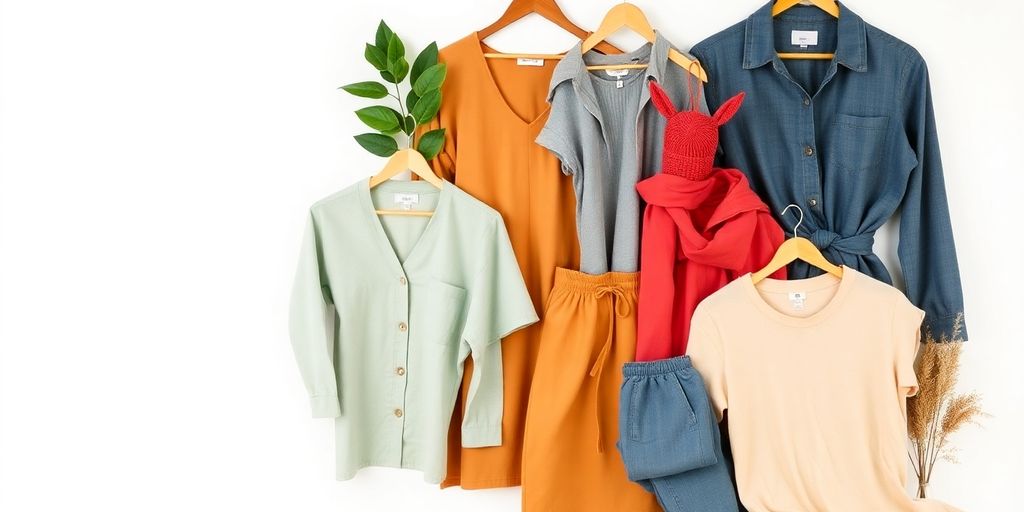
Fair Labor Practices in Fashion
Fashion brands today are under the microscope for how they treat their workers. Fair labor practices ensure that employees are paid fairly and work in safe conditions. Some brands have taken significant steps to improve this by adopting transparent policies and ensuring that their supply chains are free from exploitation. It’s not just about what’s trendy; it’s about doing what’s right.
Community Impact of Fashion Brands
The influence of fashion brands extends beyond the clothes we wear. Many brands are now focusing on their community impact, striving to support local economies and create jobs. This can include initiatives like sourcing materials locally or engaging in community development projects. Here are a few ways brands can positively impact communities:
- Supporting local artisans and craftspeople.
- Investing in community education and training programs.
- Collaborating with local non-profits to address social issues.
Corporate Social Responsibility in Fashion
Corporate social responsibility (CSR) in fashion isn’t just a buzzword; it’s a necessity. Brands are now expected to take accountability for their environmental and social impacts. This includes reducing waste, using sustainable materials, and ensuring ethical labor practices. By embracing CSR, fashion companies can build trust with consumers and contribute to a more sustainable future.
Choosing responsible clothing involves diligence and awareness, emphasizing ethical consumption. It encourages individuals to ask critical questions and seek credible sources to make informed decisions. Learn more about making responsible clothing choices.
Conclusion
So, there you have it. When it comes to choosing between eco-friendly and conventional clothing, it’s clear that sustainable fashion is making waves for all the right reasons. Sure, it might cost a bit more upfront, but think of it as an investment in the planet’s future. These brands are not just about selling clothes; they’re about making a difference. They’re using materials that are kinder to the earth and ensuring fair treatment for workers. On the flip side, traditional fashion might be easier on the wallet, but it comes with a hefty environmental price tag. At the end of the day, it’s about what matters to you. Do you want to support a system that’s working towards a better world, or stick with the status quo? The choice is yours, and every purchase counts.
Frequently Asked Questions
What makes eco-friendly fashion different from regular fashion?
Eco-friendly fashion uses materials and methods that are kind to the Earth, like recycled fabrics and less water. Regular fashion often uses more resources and can be harmful to the environment.
Why is fast fashion usually cheaper than sustainable fashion?
Fast fashion is cheaper because it uses less expensive materials and quicker production methods. Sustainable fashion focuses on quality and fair worker treatment, which can cost more.
Can a brand be both sustainable and affordable?
Yes, some brands try to be both sustainable and affordable by using innovative materials and efficient production methods. It can be a challenge, but it’s possible.
How can I tell if a clothing brand is eco-friendly?
Look for brands that use organic or recycled materials, have eco-friendly certifications, and share information about their sustainable practices.
Is sustainable fashion just a trend?
Sustainable fashion is more than a trend; it’s a movement towards better environmental and social practices in the fashion industry. It’s about making lasting positive changes.
What is the impact of my clothing choices on the environment?
Your clothing choices can impact water use, pollution, and carbon emissions. Choosing sustainable options helps reduce these negative effects.

